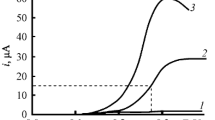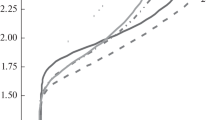Abstract
The electroreduction (ER) of benzo[a]phenazine-7,12-dioxide (1) and 2-ethoxycarbonyl-3-methyl-quinoxaline-1,4-dioxide (2) in DMF on a glassy carbon electrode is studied by the methods of cyclic voltammetry, chronoamperometry, and electrolysis at controlled potential. In aprotic medium, these compounds are reduced to form relatively stable complexes as observed in both cyclic voltammetry curves and UV spectra. The deoxygenation of the derivatives of phenazine and quinoxaline N,N′-dioxides proceeds as a result of decomposition of the radical formed either at the ER of complexes of these compounds with СН3СООН or as a result of protonation of radical anions. For compound 2, the competition between the reactions of decomposition and ER of this radical is observed.








Similar content being viewed by others
REFERENCES
Da Cunha, J., Lavaggi, M.L., Abasolo, M.I., Cerecetto, H., and Gonzalez M., 2D- and 3D-quantitative structure-activity relationship studies for a series of phenazine N,N'-dioxide as antitumour agents, Chem. Biol. Drug Des., 2011, vol. 78, p. 960.
Pachon, O. G., Azqueta, A., Lavaggi, M.L., Lopez de Cerain, A., Creppy, E., Collins, A., Cerecetto H., Gonzalez, M., Centelles, J.J., and Cascante, M., Antitumoral effect of phenazine N5,N10-dioxide derivatives on caco-2 cells, Chem. Res. Toxicol., 2008, vol. 21, p. 1578.
Gonda, M., Nieves, M., Nunes, E., Lopez de Cerain, A., Monge, A., Lavaggi, M. L., Gonzalez, M., and Cerecetto, H., Phenazine N,N0-dioxide scaffold as selective hypoxic cytotoxin pharmacophore. Structural modifications looking for further DNA topoisomerase II-inhibition activity, Med. Chem. Commun., 2013, no. 4, p. 595.
Lavaggi, M.L., Cabrera, M., Pintos, C., Arredondo, C., Pachon, G., Rodrıguez, J., Raymondo, S., Pacheco, J.P., Cascante, M., Olea-Azar, C., Lopez de Cerain, A., Monge, A., Cerecetto, H., and Gonzalez, M., Novel phenazine 5,10-dioxides release •OH in simulated hypoxia and induce reduction of tumour volume in vivo, ISRN Pharmacol., 2011, Article ID 314209. https://doi.org/10.5402/2011/314209
Chowdhury, G., Sarkar, U., Pullen, S., Wilson, W.R, Rajapakse, A., Fuchs-Knotts, T., and Gates, K.S., DNA strand cleavage by the phenazine di-N-oxide natural product myxin under both aerobic and anaerobic conditions, Chem. Res. Toxicol., 2012, vol. 25, p. 197. https://doi.org/10.1021/tx2004213
Fuchs, T., Chowdhury, G., Barnes, Ch.L., and Gates, K.S., 3-Amino-1,2,4-benzotriazine 4-oxide: characterization of a new metabolite arising from bioreductive processing of the antitumor agent 3-amino-1,2,4-benzotriazine 1,4-dioxide (tirapazamine), J. Org. Chem., 2001, vol. 66, p. 107.
Anderson, R.F., Shinde, S.S., Hay, M.P., Gamage, S.A., and Denny, W.A., Activation of 3-amino-1,2,4-benzotriazine 1,4-dioxide antitumor agents to oxidizing species following their one-electron reduction, J. Am. Chem. Soc., 2003, vol. 125, p. 748.
Yin, J., Glaser, R., and Gates, K.S., On the reaction mechanism of tirapazamine reduction chemistry: Unimolecular N−OH homolysis, stepwise dehydration, or triazene ring-opening, Chem. Res. Toxicol., 2012, vol. 25, p. 634. https://doi.org/10.1021/tx200546u
Shen, X., Laber, Ch.H., Sarkar, U., Galazzi, F., Johnson, K.M., Mahieu, N.G., Hillebrand, R., Fuchs-Knotts, T., Barnes, Ch.L., Baker, G.A., and Gates, K.S., Exploiting the inherent photophysical properties of the major tirapazamine metabolite in the development of profluorescent substrates for enzymes that catalyze the bioreductive activation of hypoxia-selective anticancer prodrugs, J. Org. Chem., 2018, vol. 83, no. 6, p. 3126. https://doi.org/10.1021/acs.joc.7b03035
Cimmino, A., Evidente, A., Mathieu, V., Andolfi, A., Lefranc, F., Kornienko, A., and Kiss, R., Phenazines and cancer, Nat. Prod. Rep., 2012, vol. 29, p. 487. https://doi.org/10.1039/c2np00079b
Cerecetto, H., Gonzalez, M., Lavaggi, M.L., Azqueta, A., Lopez de Cerain, A., and Monge, A., Phenazine 5,10-dioxide derivatives as hypoxic selective cytotoxins, J. Med. Chem., 2005, vol. 48, p. 21.
Hay, M.P., Gamage, S.A., Kovacs, M.S., Pruijn, F.B., Anderson, R.F., Patterson, A.V., Wilson, W.R., Brown, J.M., and Denny, W.A., Structure-activity relationships of 1,2,4-benzotriazine 1,4-dioxides as hypoxia-selective analogues of tirapazamine, J. Med. Chem., 2003, vol. 46, p. 169.
Lavaggi, M.L., Nieves, M., Cabrera, M., Olea-Azar, C., Lopez de Cerain, A., Monge, A., Cerecetto, H., and Gonzalez, M., Structural modifications on the phenazine N,N′-dioxide-scaffold looking for new selective hypoxic cytotoxins, Eur. J. Med. Chem., 2010, vol. 45, p. 5362.
Abu El-Haj, M. J., Dominy, B. W., Johnston, J.D., Haddadin, M.J., and Issidorides, C.H., A New route to phenazine 5,10-dioxides and related compounds, J. Org. Chem., 1978, vol. 7, no. 4, p. 589.
Lavaggi, M.L., Cabrera, M., Aravena, M. de los A., Olea-Azar, C., Lypez de Cerain, A., Monge, A., Pachyn, G., Cascante, M., Bruno, A.M., Pietra-santa, L.I., Gonzalez, M., and Cerecetto, H., Study of benzo[a]phenazine 7,12-dioxide as selective hypoxic cytotoxin-scaffold. Identification of aerobic-antitumoral activity through DNA fragmentation, Bioorg. Med. Chem., 2010, vol. 18, p. 4433.
El-Gogary, S.R., Waly, M.A., Ibrahim, I.T., and El-Sepelgy, O.Z., Synthesis and UV absorption of new conjugated quinoxaline1,4-dioxide derivatives anticipated as tumor imaging and cytotoxic agents, Monatsh. Chem., 2010, vol. 141, p. 1253. https://doi.org/10.1007/s00706-010-0386-1
Romeiro, N.C., Aguirre, G., Hernandez, P., Gonzalez, M., Cerecetto, H., Aldana, I., Perez-Silanes, S., Monge, A., Barreiro, E.J., and Lima, L.M., Synthesis, trypanocidal activity and docking studies of novel quinoxaline-N-acylhydrazones, designed as cruzain inhibitors candidates, Bioorg. Med. Chem. 2009, vol. 17, p. 641.
Kulakovskaya, S.I., Krivenko, A.G., Komarova, N.S., Kulikov, A.V., and Shestakov, A.F., Electrochemical and ESR study of the mechanism of oxidation of phenazine-di-N-oxide in the presence of cyclohexanol on glassy carbon and single-walled carbon nanotube electrodes, Russ. J. Electrochem., 2014, vol. 50, p. 1.
Miyazaki, H., Matsuhisa, Y., and Kubota, T., Cyclic voltammetry of aromatic amine N-oxides in nonaqueous solvents and the stability of the free radicals produced, Bull. Chem. Soc. Jpn., 1981, vol. 54, p. 3850.
Ryzhakov, A.V., Alekseeva, S.A., and Rodina, L.L., New trends in the chemistry of molecular complexes of heteroaromatic N-oxides, Vestn. St.-Petersburg Univ., Ser. 4, 2009, no. 1, p. 67.
Koldasheva, E.M., Shestakov, A.F., Geletii, Yu.V., and Shilov, A.E., Formation and redox properties of a complex of phenazine di-N-oxide with a proton, Bull. Russ. Acad. Sci. Chem., 1992, vol. 41, no. 4, p. 655.
Koldasheva, E.M., Strelets, V.V., Tse, Y.K., Geletii, Yu.V., and Shestakov, A.F., Phenazine di-N-oxide radical cation and its reaction with hydrocarbons, Russ. Chem. Bull., 1996, vol. 45, no. 8, p. 1889.
Tabner J. and Yandle J.R., A Correlation of half-wave reduction potentials with theoretical calculations for some nitrogen-containing heteromolecules in dimethylformamide, J. Chem. Soc. A, 1968, p. 381.
Mendkovich, A.S., Syroeshkin, M.A., Mikhalchenko, L.V., Mikhailov, M.N., Rusakov, A.I., and Gul’tyai, V.P., Integrated study of the dinitrobenzene electroreduction mechanism by electroanalytical and computational methods, Int. J. Electrochem., vol. 2011, Article ID 346043. https://doi.org/10.4061/2011/346043
Chowdhury, G., Kotandeniya, D., Daniels, J.S., Barnes, Ch.L., and Gates, K.S., Enzyme-activated, hypoxia-selective DNA damage by 3-amino-2-quinoxalinecarbonitrile 1,4-di-N-oxide, Chem. Res. Toxicol., 2004, vol.17, no. 11, p. 1399. https://doi.org/10.1021/tx049836w
Ganley, B., Chowdhury, G., Bhansali, J., Daniels, J.S., and Gates K.S., Redox-activated, hypoxia-selective DNA cleavage by quinoxaline 1,4-di-N-oxide, Bioorg. Med. Chem., 2001, vol. 9, p. 2395.
Author information
Authors and Affiliations
Corresponding author
Ethics declarations
The authors declare the absence of conflict of interests.
Additional information
Translated by T. Safonova
Published on the basis of materials of the XIX All-Russian Conference “Electrochemistry of Organic Compounds” (EKHOS-2018) (with international participation), Novocherkassk, 2018.
Rights and permissions
About this article
Cite this article
Mikhal’chenko, L.V., Nasybullina, D.V., Leonova, M.Y. et al. Electroreduction of Derivatives of N,N'-Dioxides of Phenazine and Quinoxaline in Nonaqueous Media and in the Presence of Proton Donors of Medium Strength. Russ J Electrochem 56, 388–395 (2020). https://doi.org/10.1134/S1023193520040102
Received:
Revised:
Accepted:
Published:
Issue Date:
DOI: https://doi.org/10.1134/S1023193520040102




